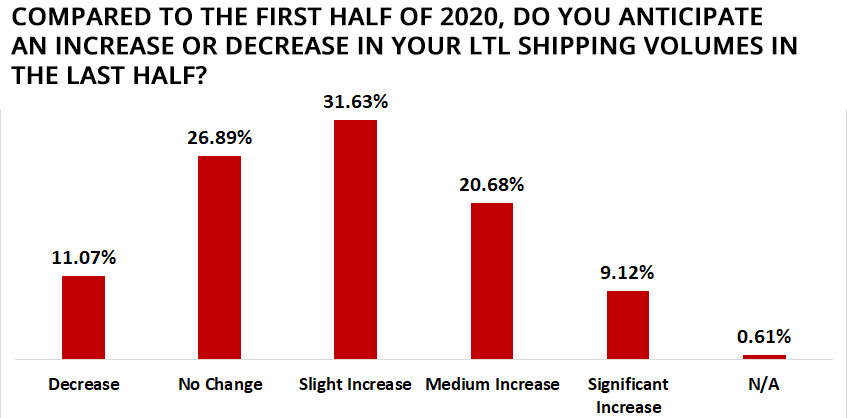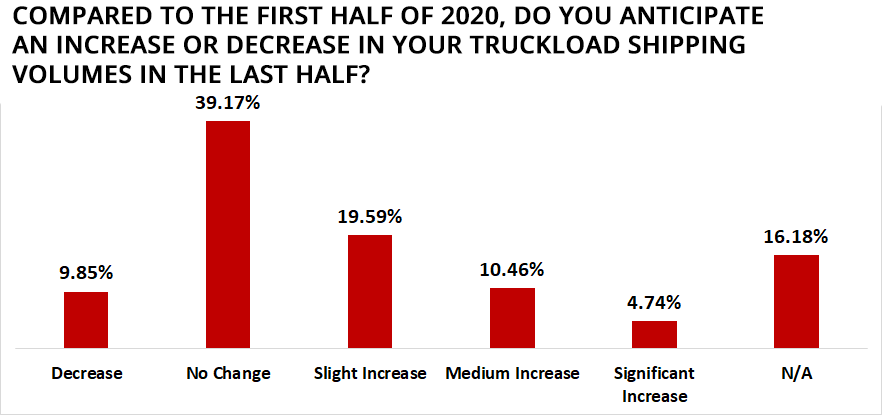In the early part of 2020, many businesses across the globe were temporarily shut down due to local
mandates and precautionary measures. As a result, sales across many different industries significantly
slowed.
Additionally, many shippers that depended on imported raw materials and products were forced into a state of supply chain limbo as manufacturing economies such as China shut down for weeks at a time.
A lack of consumer demand resulted in fewer shipments, while import challenges prevented others from meeting consumer demand. As a result, LTL and truckload capacity reached all-time highs, forcing many
carriers to temporarily furlough drivers. In the same breath, several carriers chose to close their doors permanently.
By July, the nation was increasingly adapting to the crisis and supply chains were picking up more steam.
When we asked shippers whether they predicted an increase in LTL shipping volumes in the second half of
the year compared with the first, only 11.07% foresaw a decrease. Significantly, 61.43% of shippers predicted an increase. At the same time, 26.89% of shippers surveyed expected no change in their shipping volumes.

When it came to expectations for truckload volumes, only 9.85% of the shippers surveyed expected a decrease compared with 34.79% that predicted an increase in the last half of 2020. Out of those surveyed, 39.17% did not foresee any changes in their full-load volumes.

Recent data and reports from market analysts back up the positive outlook seen by many shippers. At the same time, freight congestion along the West Coast and pentup demand across the country has created challenging conditions for many LTL and truckload shippers.
Capacity out of high-volume import areas, such as Los Angeles and Long Beach, has led to transit delays for many shippers using LTL and truckload services. Additionally, the demand has created challenges within the intermodal markets out of the West Coast that feed freight into the rest of the nation. One of the primary challenges of meeting the surging demand is the task of bringing back furloughed employees and putting equipment back into operation.
“U.S. railroads furloughed engineers and crews during the downturn in March and April, but recently began
calling them back to handle the recovery in volumes,” wrote Ari Ashe in a recent article from the Journal of
Commerce. “Recalling labor is not a quick task because of the complex agreements between unions and U.S. railroads, which allow workers to wait a couple weeks before coming back rather than return immediately.”
The same sentiments can be applied to the trucking industry. On top of the numerous carrier closures that occurred across the nation, many drivers were furloughed. Consequently, capacity has been a primary concern for shippers struggling to meet renewed consumer demand.
A sudden fix to capacity issues on the road will not be as simple as turning on a light switch. Pricing may
fluctuate in the months to come, especially if further supply chain disruptions strike abroad or at home.
Nonetheless, now is the time that shippers should reevaluate their LTL and truckload strategies. Identify
transportation partners that are flexible to meet peaks and valleys in freight demand. Averitt, for example,
has partnered with many of its high-volume shippers to ensure that their capacity needs are met. To do this,
Averitt has been able to leverage its LTL and supply chain fleets to support its customers’ full-load needs when they arise.
Simply put, don’t put all your eggs in one basket … unless that basket can handle the changing demands and challenges you may encounter ahead.
Averitt is a leading supply chain and logistics solutions provider. As an asset-based carrier, Averitt offers LTL, truckload and dedicated fleet solutions.








